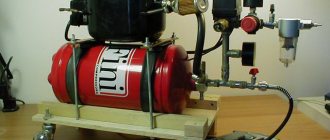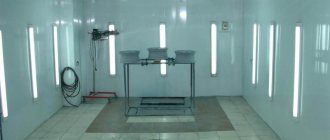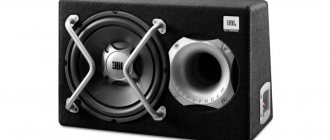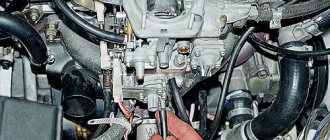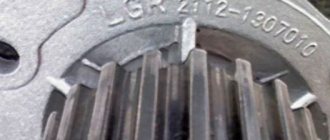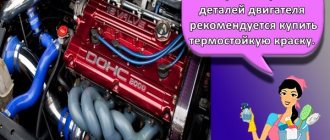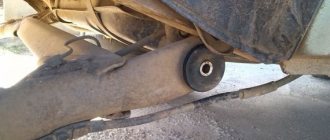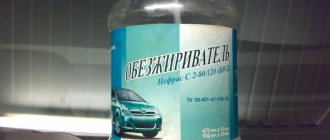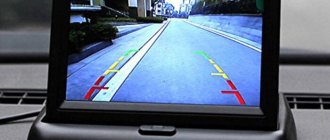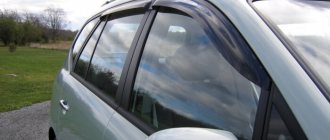DIY headlight washer installation
Before you begin installing the device, evaluate the possibility of how to incorporate a headlight washer into your car at minimal cost.
The best option is when the washer pump can be implanted into the standard pump. However, this is not feasible for all car models. Quite often, a standard pump is installed near the bumper in the fender area. There may be cases when the standard tank is not compatible with the pump, and it is necessary to install an additional fluid reservoir and install the nozzles directly on the bumper. To install a headlight washer yourself, you first need to remove the front bumper and drill a hole. If this is unacceptable for you, then it is better to immediately abandon this idea. For convenience, we drill a hole on the bumper in several steps. First we make a small diameter, and then we drill it out to the desired size. The washer nozzles should be installed symmetrically, directly opposite the center of the headlamp. Special fasteners are provided for attaching the injectors.
After the nozzles and washer pump are installed, we connect all the components into a single system using valves, pipes and tees, according to the instructions that come with the kit. The pump must be connected to power. This can be achieved by powering it from a standard pump through an additional relay. In this case, the headlight washers will be turned on automatically along with the activation of the windshield system. The disadvantage of this connection is the increased fluid consumption, and many owners wonder how to disconnect the headlight washers from the standard system. In this case, you can install an additional button for turning on the headlight washer mechanism by extending separate wiring into the car interior.
Advantages of modern washers
Reliable headlight washers from Hella and other brands are installed in any car. The device is an excellent replacement for brush washers.
The advantages of modern models are as follows:
- safety for plastic headlights - treatment with liquid does not lead to scratches or clouding of the surface of the optics;
- increase driving safety - headlight washers are indispensable when using xenon, which, when contaminated, leads to blinding of drivers of oncoming cars;
- the possibility of joint control with the headlights - so when the low beam is turned on, the washer starts automatically;
- high level of reliability – after installation the device works flawlessly for many years.
Sources
- https://dorpex.ru/avtomobilnyie-sovetyi/remont-avtomobilya/kak-postavit-svoimi-rukami-na-faryi-omyivatel
- https://DriverTip.ru/repair/kak-ustanovit-omyvatel-far-samostoyatelno.html
- https://VipWash.ru/ustanovka/omyvatel-far-svoimi-rukami
- https://7road.ru/komplektacii/omyvatel-far-na-kalinu.html
- https://autolirika.ru/tuning/omyvatel-far-svoimi-rukami.html
- https://nadouchest.ru/sdelat-omyvatel-far-svoimi-rukami/
- https://auto-gl.ru/ustanovka-omyvatelya-far-svoimi-rukami-v-podrobnostyah/
- https://pricep-vlg.ru/auto-gadget/omyvatel-far/
- https://www.DriveNN.ru/journal/novosti/kak-ustanovit-omyvateli-far-svoimi-rukami-id30171
- https://ziesta.ru/uslugi/avtosvet/ustanovka-omyvateley-far
How to install the kit
Now I’ll tell you how such devices are installed. If you have already purchased a universal headlight washer with all the components listed above, then you can read the installation instructions.
In general, each washer comes with a diagram from the manufacturer with detailed instructions and recommendations. Plus, each car has its own characteristics. This does not allow installing a universal kit on all cars according to an identical scheme. There will be some differences.
But the general principle is based on the following:
Since the connection diagram is included in the kit and it is not universal for all washers and cars, I will not give any specific advice here.
In practice, there is nothing complicated about installing headlight washers. You need to initially take a good kit, think about the installation location, and complete the installation without rushing and without trying to violate the manufacturer’s recommendations. Especially regarding the electrical circuit and power supply
Remember the importance of good insulation. Good luck to you!
Thank you for reading us! Subscribe, leave comments and ask questions if you have any!
Watch this video on YouTube
Steps to install the headlight washer yourself
Components are purchased for a specific brand of car and must fit into the overall design.
Important. The kit should include a sprayer cover to avoid drilling the bumper.
Installation instructions for headlight washer:
- Inspect the reservoir used to wash the windshield in order to insert an additional tube. If this is not possible, then you should find a place to install the tank from the kit.
Important. The tank is mounted at a distance from parts that can heat up.
- You need to find a place to install the injectors. The optimal placement is opposite to the center of the headlight.
Note. To determine the center of the headlight, you need to take a closer look at the lens; the center will be in the shape of a circle.
- A small diameter hole is drilled on the bumper and then expanded to the required size. The process requires care and precision and is performed from the outside to avoid paint lifting.
- Secure the spray mechanism.
- The tank and pump are installed. The installation procedure differs depending on the kit.
- Communications are extended taking into account the shortest distance.
- Connect to the electrics, connect the pump to the general electrical circuit, make the control in the form of a separate button. Alternatively, it can be connected to a windshield washer.
Note. When installing a separate button, questions arise regarding the choice of location and connection. When installed on a standard washer, there will be a large consumption of solution.
Installation Guide
To install a universal device, no special abilities are required. The only obstacle that a car enthusiast may encounter is independently drilling holes in the tank to secure the injectors. To do this manipulation, you need to remove the bumper from the car and make several holes on the back side. The headlight washer cover must be repainted depending on the color of the car. After this, it is necessary to secure the nozzles in the already prepared hole. To install a pump in a car, you need to equip the tank with one more hole, then secure the pump with electrical tape. After the work has been done, you can install the tank in a pre-prepared place
It is important that the tank is not located near components that can reach high temperatures.
After the above steps, you can return the car bumper to its place and finish the job - install hoses, valves and tees.
Exploitation
Operation will vary depending on the equipment and installation option selected.
Headlight washer Skif
For example, if the device is combined with a windshield wiper button, then the liquid consumption will increase several times, because to supply high-pressure water you will have to constantly add liquid to the tank.
To avoid abuse, you can connect the device to a separate button in the cabin. This is also convenient in winter, because then water can damage the system pump. If the lighting accessories freeze to the bumper during operation, then the headlight washer motor will be damaged.
To ensure proper operation of the system, it must be tested periodically. This will help prevent contamination of the injectors and extend the life of the device. Some drivers, in order to keep the device in good condition, remove the fuses from the system when frost sets in.
Inclusion rules
The ideal location for installing the control module is the ignition, alarm column. Secure the white wire to the plus contact on the side lamp, connect the red wire through a fuse to the voltage source.
Connect the red and black wires to the plus and minus of the washer. Connect the blue wire to the plus of the cigarette lighter illumination or to the contact that is responsible for the overall disconnection.
The assembled structure must be tested. Fill the reservoir with washer fluid or plain water and analyze the operation of the nozzles and liquid spray. If desired, the headlight washer can be installed on any car. It is important to have the parts on hand, study the connection diagram, choose a location for the tank and button, and install. The procedure is not complicated and even a novice driver can handle it.
How the headlight washer works
There are several different design options for such devices installed on a car. These are the so-called:
- low pressure washers (with headlight wipers);
- high-pressure washers, when the headlights are cleaned with a jet of liquid.
The design of these products differs radically. The principle of cleaning headlights, implemented in low-pressure washers, completely replicates the work of windshield wipers. You can see what similar washers look like on a car in the photo.
A stream of water or other washing liquid is directed onto the surface of dirty headlights, for which a special nozzle is used, most often more than one, which allows you to evenly clean the entire surface.
Self-installation
- Remove the bumper from the car.
- Drill a hole in the washer reservoir, install the rubber seal and pump.
- Pull the hoses in the direction of the sprayers, install a tee.
- Mark the approximate installation location. The jet nozzles are attached to the bumper only. Telescopic products can be attached either to the bumper with self-tapping screws or to a metal bumper reinforcement. If the injector body in the retracted position does not rest against the amplifier, then you can choose the option with self-tapping screws or with the manufacture of a special bracket for attaching the injectors to the bumper stiffeners. On some cars it is not possible to use this option, since the bumper is located too close to the amplifier. In this case, the retractable nozzles are attached to the amplifier in such a way that, when lowered, the decorative covers are completely adjacent to the bumper, and in operating condition, the adjustment range of the nozzles allows the jet of liquid to be directed directly to the lamp area.
- Make markings. To do this, it is most convenient to stick masking tape on the bumper, mark the location of the nozzle, and then measure the distance from it to several points on the headlight. Then, after removing the bumper, repeat the measurements as accurately as possible to understand how the injectors should be positioned in the retracted position.
- Install the nozzles on the minimum number of fittings for fitting (if possible, secure them with glue). Drill a hole large enough to go through the spray body. If nothing interferes with the extension, securely fasten the nozzle and decorative cover.
- Install the hoses;
- Connect the power, check the operation of the system, the reliability of the wires and hoses.
- Adjust the nozzles.
Power connection
In a simpler, but no less functional, version, a conventional 4-pin relay is used to connect power. Take the power “plus” directly from the battery, placing a fuse of the required rating as close as possible to the battery (how to calculate the fuse rating). Connect the control plus from it. Screw the power minus to ground, and stretch the control minus wire to the button in the cabin. The button must be normally open, without locking. Connect one pin of the button to the control minus of the relay, and the second to ground inside the cabin. When the button is pressed, the contacts will close, causing the pump to turn on.
Detailed installation instructions
Installing a headlight washer does not require any special skills and can be done by any car enthusiast. If the manufacturer does not provide special holes, you will have to drill them to secure the injectors. To do this, you need to remove the bumper and carefully make holes on the back side.
The nozzles are placed opposite the central part of the headlights, so you need to carefully measure the distance in accordance with the installation instructions. The exception is bi-xenon headlights, which cannot be used without a washer. In this case, the nozzles are located away from the center of the headlights.
The washers themselves can be repainted to match the color of the car, but to do this you need to determine the paint number. We fix the nozzles in the hole made and check the quality of the fastening. Pay attention to the location of the headlight washer nozzle cap.
To install the pump, drill a hole in the tank and secure it using a rubber seal; if necessary, secure the device with electrical tape. After this, we mount the tank in the selected location and place a special tee valve to distribute the liquid in the system.
Important! Under no circumstances should the tank and hoses be placed near units with high temperatures.
After installing the bumper in its usual place, we install the hoses, necessary valves and tees. According to the instructions, we connect the headlight washer pump to the car electronics. If the pump is located inside the windshield wiper reservoir, then without a special headlight washer relay it will operate together with the wipers. If the pump is located in a separate tank, then it will start when you press a special button in the cabin. In any case, you can customize its operation to your taste.
Connection and testing
The most suitable location for installing the control unit is the alarm column and the ignition unit. To do this, the white wire is connected to the positive contact of the parking light. After which the red wire is connected through a fuse to the energy source. The black and red wires coming from the tie with the white are connected to the negative and positive contacts of the washer itself. The blue wire is connected to the positive contact of the car cigarette lighter illumination or to the headlight switch off contact.
It is worth testing the assembled system after installation before continuous operation; for this you need to pour a special liquid into the tank, but distilled or boiled water will also work.
Important! During winter operation, water can render the pump unusable.
Nuances of choice
If, due to life circumstances, your car is used most of the time in difficult conditions, the idea of installing headlight washers will definitely come to your mind, and sooner rather than later.
This means that you will have a difficult time choosing the right device.
Here, a lot depends on the design of the front part of your car - the shape and location of the bumper and head optics. In principle, stores offer kits designed for certain models, but if you don’t like them, you can easily choose another one. There are three types of nozzles according to the method of their attachment: on a bumper, the top of which is flat or semicircular
On SUVs, the bumper is larger, so pay attention to kits with extended injectors
Since standard kits do not include a washer reservoir, you should purchase it separately, having decided in advance where you will install it. If a suitable place cannot be found, the only option left is to connect the PF to the standard windshield cleaning system. It is characterized by wasteful consumption of working fluid, so it should be used only as a last resort.
Please note that there should be no sources of thermal radiation at the location where the tank is installed, easy access to it should be provided, and it is advisable to ensure a minimum distance to the nozzles.
We advise you to choose only high-quality products from well-known and well-established companies. Regarding headlight washers, lighting companies Hella and Sho-me are considered such.
The latter is characterized by an excellent combination of quality and cost. This Chinese manufacturer offers devices that are easy to install, inexpensive and quite suitable for active use.
But if your priorities are only slightly related to cost, then preference should be given to products from the European company Hella. Its washers have international quality certificates, which says a lot, but also contributes to pricing. You can rest assured that the service life of these devices will be significantly greater than that of their Chinese counterparts.
It is Hella that offers telescopic headlights, which are chosen by those car owners who value the appearance of their car.
How to test the headlight washer operation
It is best to install the OF control unit in the steering column or ignition switch unit, but you may well prefer other options that are more convenient for your car. We direct the white wire from the control unit to the positive terminal of the side light, connect the red wire to the supply wire, but always through a fuse (you should choose the one with the least load on consumers). We connect the black and red wires in series to the positive and negative contacts of the washer, the last blue wire is in the positive terminal of the cigarette lighter socket illumination (as an option - to the contact that turns off the side lights).
When the electrical part of the work is completed, you can begin testing the operation of the washer. Fill the tank with working fluid and press the power button. We make sure that the pump and nozzles are working, carefully check how well the jet flows and whether it completely covers the diffuser. If there are still unaffected areas, you can try to correct the situation using gaskets or bending the injector barrel.
We recommend: Repair instructions for Vanos M50, M50TU, M52
As you can see, using a headlight washer is very simple, since in general the principle of operation is the same, and with a combined installation option, both devices function as a single mechanism. But caring for a headlight washer will require more effort from you than servicing a standard device. The main enemy of PF is dirt. Since the nozzles are located in an unprotected place, they, as well as the valve in the tank, are susceptible to contamination, which can lead to loss of performance of the device or a significant deterioration in cleaning the headlights - heavily soiled nozzles will spray liquid rather than spray it.
At the stage of installing the washer, you need to ensure that during installation no foreign objects or dirt get into the basque; the liquid being poured must also be perfectly clean. Tap water is by no means the most optimal solution, but if there is no other option, be sure to boil it before use. But it’s better to run to the nearest pharmacy and buy the right amount of distilled water that does not contain any impurities
Just as a housewife uses cleaning products when washing dishes, car owners can pour a small amount of regular car shampoo into the tank, which will allow them to easily deal with outdated, dried and difficult to remove stains that ordinary water cannot handle. Please note that this operation should only be carried out in the summer. In winter, the same antifreeze liquid is poured into the reservoir as into the windshield washer. It does not require any additives - ethylene successfully copes with the task of dissolving old contaminants. In addition, additives of unknown origin may freeze if they enter the pump, which will completely disable it.
Do not forget to change the fluid in time when the season changes, especially when switching from warm to cold seasons.
Another concern associated with caring for the headlight washer is regular cleaning of the injectors. Don’t forget to wipe the headlights as well, since the washer does not clean them perfectly evenly. Remember that running the pump idle for a long time can cause it to fail. If the system is combined, you will notice this by the absence of a stream from the head washer nozzles, but if you use a separate device, you will not see whether there is liquid in the system. So check its level regularly and top up if necessary.
Periodically check the reliability of all fasteners and inspect the wiring for damage. If circumstances do not require the use of headlight washers, turn them on during long periods of inactivity, even if this is not necessary, since this is necessary to clean the injector nozzles.
Summarizing the above, we note that headlight washers are a really necessary device, but you should not count on the ideal condition of the headlight lenses - after all, the wipers do not cope with their task perfectly. And if your car is equipped with xenon optics, then you simply need a headlight washer.
What kind of headlight washer can it be?
There are two types of this device; they differ in the principle of cleaning the diffuser. A jet headlight washer does this using a high-quality jet of water under high pressure, which knocks off all possible dirt. No other intervention in the cleaning process is required. Today this is the most popular type of washer, and everything depends on modern headlights, now they are all plastic. Plastic does not tolerate any friction, so traditional brushes are not suitable for it.
As has already become clear, the second type of washer is a brush washer. Everything is very clear here, the process is similar to washing glass: water is supplied in a lazy stream to the lens, and the brushes, controlled by the headlight washer motor, diligently rub the surface. But in a modern car, such a rarity is no longer found, because only glass can withstand such a cleaning scheme, and the mass auto industry tries not to make car headlights from this material. Therefore, you are unlikely to find such a kit on sale for self-installation.
Types of headlight washers
Depending on the principle of glass cleaning, headlight washers come in two types: brush (low pressure) and jet (high pressure).
- Brush washers are a special mechanism provided by the design, in the form of small wipers on the headlight glazing. When cleaning, a small amount of liquid is applied to the headlight glazing, and a moving brush removes dirt. The disadvantage of brush cleaners is that they can only be used on headlights with glass lenses. Plastic optics are more susceptible to mechanical damage and brushes can severely scratch the surface. Mounting and installing a brush device on a car yourself is quite problematic. At the same time, it is much easier to assemble and install a jet headlight washer with your own hands.
- Jet washers are simpler and more versatile. You can buy them as a kit and install them on your car yourself. At the same time, inkjet devices are compact and easy to use. The operating principle of jet devices is that the kinetic energy of a liquid jet is used to clean glass. The cleaning effect depends on the angle of the jet, pressure, volume of liquid sprayed and the distance from the nozzle to the diffuser.
Design
Depending on the design of the headlights, you can choose the optimal cleaning system. There are two main types of headlight washers: brush and jet. The brush washer is difficult to install, as it is a mechanism of small wipers on the surface of the headlight glass.
The nozzles deliver a small amount of liquid and the brush removes accumulated dirt. You should not use this type on headlights with plastic optics, as over time the surface will be covered with many scratches. A jet washer cleans headlights of any type by supplying liquid under high pressure. Installation of such a mechanism is much simpler, since it eliminates the brush from the design.
Main components of the washer
Let us consider the composition of a typical device using the example of a high-pressure RP, that is, a jet type.
Structurally, such a car accessory consists of the following elements:
- a pump that generates high pressure when the washer is turned on;
- connecting hoses;
- containers for storing a supply of working fluid;
- nozzles;
- control block.
Let us describe the features of the device and functioning of all of the above components.
Tank
It is not difficult to guess that its main task is to provide the washer with liquid used to clean the headlight glasses. You can use an already installed reservoir that serves the wipers, which will have to be refilled much more often. But there is an alternative option - installing a separate container, for which you need to find free space (and this is always a problem in the engine compartment) and securely strengthen it, preferably closer to the front of the car. Often such a tank is installed directly under the bumper.
Please note that when purchasing a ready-made kit, you should not expect that it will also contain a container for liquid - it will need to be purchased separately.
Pump
Its purpose is to direct washer fluid to the nozzles under a certain pressure. The operation of the pump, which belongs to the actuators, is controlled by signals coming from the control unit.
Connecting hoses
It is through them that fluid is supplied from the tank to the injectors. The main requirement for hoses is resistance to aggressive substances (fuel, motor oil, antifreeze) and the ability to operate for a long time at elevated pressure. To reduce energy losses, it is desirable that their length be minimal, for which the tank should be placed close to the headlights.
Injectors
The irony is that the nozzles designed to clean the headlight glass from dirt themselves become clogged over time and require cleaning procedures. It is this component that determines how effectively the washer will work. The correct initial installation of the nozzles is of great importance, and the design features and condition of the nozzles determine the flow rate of the working fluid. An injector block may consist of one or more pooled elements.
As a rule, nozzles are mounted on a bumper, which may differ in shape and geometric dimensions for different models, so you should purchase a kit designed for installation on a specific bumper shape:
- flat;
- spherical shape;
- high height (typical for off-road vehicles).
Special mention should be made of telescopic nozzles. They are installed under the bumper; only a small part of the cover looks out, which practically does not affect the exterior of the car. Based on a signal received from the device control unit, a hydraulic piston is activated, which causes the telescopic mechanism to operate, extending the nozzle to the headlights. At the end of the washer operation, the nozzle hides in its normal place.
Although this is a more complex and expensive design, it is believed that the telescopic washer works more efficiently - due to the selection of the optimal distance to the surface of the headlamp and the ability to set the required direction of the nozzles. Please note that in winter there is a possibility of the lid jamming as a result of exposure to moisture and low temperatures.
Control block
The design and operating principle of the control unit may vary. The simplest and most reliable option is to use a relay, which controls the operation of the pumping unit. The relay is activated by a button located in the cabin. This implementation allows you to turn on the OF independently of the operation of other systems, in particular, the windshield washer, which allows you to save a considerable amount of washer fluid.
The second option is to connect the headlight washer to the standard system. In this case, there is no need to install a separate button - the headlights will be cleaned together with the windshield. Installing a headlight washer with your own hands using this method is easier, and it is possible to program the control unit in such a way as to alternate the operation of the OS and OF. But in any case, such an implementation is associated with an obvious overconsumption of washer fluid.
However, there are also more intelligent devices on sale that use more advanced algorithms, but their cost will be much higher.
Possible damage to the windshield washer
Washer failures are divided into electrical and mechanical. Mechanical faults are much more common than electrical faults, however, and they are much easier to fix.
We list the malfunctions that arise for mechanical reasons:
- The washer fluid in the reservoir has run out. If there is no fluid in the reservoir due to damage, it is recommended to replace it immediately. In addition, the fluid can freeze if it is selected incorrectly (for example, when using washer fluid in winter intended for use in summer).
- Perhaps the hose came off the jets, or it was crushed.
- Liquid cannot pass through the nozzles. This is possible if there are any foreign impurities in the washer fluid, but it happens that the injectors are simply clogged with dirt.
We recommend: Tuning VAZ 2101 - tuning the engine, suspension, headlights, interior VAZ 2101 - TS
The second group of reasons leading to incorrect operation of the washer includes electrical faults. Let's list them:
- Blown fuse.
- The washer motor is not receiving power. In this case, the cause of the breakdown lies in the washer terminals, which will oxidize over time and sometimes fall off. Such a malfunction is detected by visual inspection.
- Broken relay, faulty wiring, switch or washer motor. Such a breakdown can be calculated using a multimeter connected to the terminals of the electric motor. The absence of voltage will confirm the presence of a breakdown. In cases where there is voltage, but the washer still does not function, we can conclude that its motor is broken, which will need to be replaced immediately.
- The pump terminals are oxidized. As noted just above, the terminals oxidize during operation, which in turn leads to the cessation of fluid pumping due to a failed motor. It is possible to restore their functionality; for this purpose, the oxidized terminals must either be cleaned or replaced with new ones.
What does a car headlight washer consist of?
The optimal PF option is selected based on the shape and size of the optics. Currently, two design types of washers are most widespread: jet and brush. As you might guess, the brush version is similar in principle to classic wipers. However, this mechanism is quite difficult to install and is not very reliable, since it is based on mechanical components that are subject to both wear and external mechanical influences.
A small volume of working fluid is supplied to the nozzles, which is sprayed onto the headlights, and the brushes remove washed-off dirt. If the car has plastic optics installed, the brushed OP will quickly cover it with a network of scratches, which will significantly impair the transparency of the lens.
Jet washers differ from brush washers in the absence of a mechanical element - here contaminants are removed under the influence of a jet of liquid supplied to the optics under pressure.
That is why this type has become more widespread.
Operation and repair
The operation of the device in question will depend both on the equipment itself and on the installation option. If the washer is combined with a windshield wiper button, the fluid will be consumed faster and the reservoir will need to be filled frequently to supply it under high pressure. To reduce consumption, the device is connected to a separate button, which is located in a convenient place. Operating the system from a separate button pays off, especially in winter, which allows you to avoid failure of the device. Proper operation of the headlight washer requires periodic use of the system. This will not only prevent contamination of the nozzles, but will also increase the service life of the device.
In winter, the washer nozzles become clogged with dirt and freeze, which prevents the normal operation of the device. Therefore, periodic cleaning of the element is necessary
It is worth saying a few words about operation in winter. Some car owners, in order to avoid washer failures, remove the fuses along the power circuit for the winter. Since at low temperatures the nozzles become dirty and freeze, this leads to difficulties in using them if they are not cleaned. For example, retractable washers simply freeze to the bumper, which leads to pump failure.

